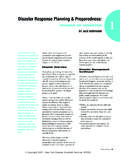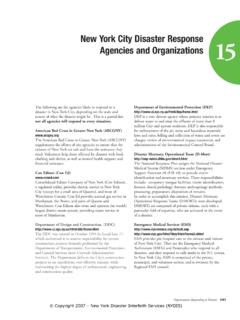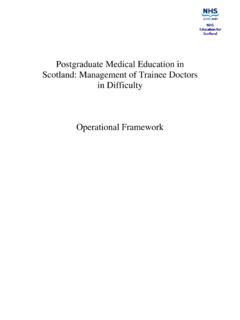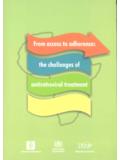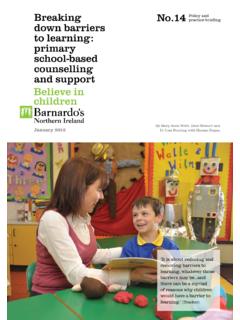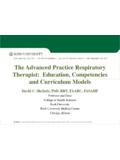Transcription of The Role of Religious Leaders in Crisis Response: 7
1 1. Introduction In a disaster, Religious Leaders are front-line, trusted caregivers to whom peoplelook for assistance and support forhealing. A primary function of Religious Leaders isthe care of the soul, which involvesshowing compassion and empathy forpeople in times of Crisis by offeringcomfort, support, clarity, direction andspiritual resources. The Religious leader is in a uniqueposition to respond to people who areimpacted by adisaster because she or heis already in an established role, has a coreof relationships, and brings a faithperspective that speaks to the need formeaning that is so pervasive in the humanexperience of learned from 9/11 that people really doturn to Religious Leaders for a poll conducted by the American RedCross of individuals emotionally impactedby the attacks on the World Trade Center: 59 percent said they were likely or mostlikely to turn to a Religious leader orspiritual guide for help; 45 percent said they would turn to aphysician.
2 40 percent said they would turn to amental health professional. Anecdotal information substantiatessimilar experiences with recovery workersat Ground Zero and families in theFamily Assistance research, predating theSeptember 11 terrorist attacks,supportsthe ARC findings: 43-60% of people who have emotionalproblems turn first to Religious Leaders forhelp; 94% of Americans believe in God; Prayer and faith are the most widely usedmethods of coping with traumatic Leaders Roles In DisasterSpiritual CareThe type of caregiving provided by religiousleaders to persons impacted by adisasterwill depend upon training and skill. At the very basic level, Religious leadersare called upon to providepsychological/spiritual first aid thatwill help the person impacted by adisaster with stabilization, normalizationand adaptation, as well as with processingwhat has happened and with makingmeaning of the experience.
3 Optimally, Religious Leaders will notonly have basic pastoral/spiritual caretraining and skillsfrom seminary orother theological/ Religious education, butwill also have specialized training in crisisintervention and trauma response and willbe able to companion a person to apositive outcome, even growth, after acatastrophic response 927 The Role of Religious Leaders in Crisis Response: CARING FOR THE SOULBY THE REVEREND WILLARD ASHLEY, THE REVEREND SUSAN LOCKWOOD The Reverend Dr. WillardWalden Christopher Ashley, Sr.,holds degrees from theFashion Institute ofTechnology; Montclair StateUniversity (Bachelor of Arts);Andover Newton TheologicalSchool (Master of Divinity; andDoctor of Ministry) andNatchez College (HonoraryDoctor of Humanities).
4 Ashleyearned certificates in Marriageand Family Therapy andPsychotherapy at the BlantonPeale Graduate taught at DrewUniversity, Andover NewtonTheological School, and TheNew York TheologicalSeminary. He is the Director ofthe Department of PastoralCare, Council of Churches ofthe City of New York. and theCo-Editor of the upcomingbook: Disaster Spiritual Care:Practical Responses toCommunity, Regional andNational Rev. Susan Lockwoodformerly served as Director ofDisaster Planning & Trainingfor New York Disaster InterfaithServices and as one of theoriginal editors of this ordained American Baptistpastor, she served as DisasterResponse Coordinator forAmerican Baptist Churches ofMetropolitan NY following9/11.
5 Copyright 2007 New York Disaster Interfaith Services (NYDIS) Religious Leaders without advancedclinical training should be clear aboutthe limits of their role as caregivers that they are not psychotherapists orpastoral counselors, and should refer thosewith severe symptoms to a trained mentalhealth professional or pastoral Religious Leaders should notdiminish the value of their role or standon the sidelines in assisting with thehealing process, they should above allelse, do no SeriousProblemsIt is important to learn the signs andsymptoms of anxiety and grief responses todisaster. Recognizing severe symptoms ofanxiety and grief that need referral forprofessional treatment is an extension ofcare, not a sign of Normal EmotionalResponses to Grief Denial, disbelief, feeling unreal Anger, blaming Difficulty concentrating Inability to organize Guilt Preoccupation with the deceased or object of loss Feelings of abandonment2.
6 Normal PhysicalResponses to Grief Sleep disturbance Restlessness or agitation Fatigue Loss of Appetite Diarrhea Rapid heart rate Headaches Numbness3. Signs of Possible Prolonged orUnresolved Grief Feels sick or that one is losing one s mind Life seems over, or meaningless Marked psychomotor retardation Uninvolved and uninterested Profound denial Delusions and illusions Active suicidal ideation Loss of faith, spiritual/ Religious crisis4. Post Traumatic Stress Disorder (PTSD)Editor s note: Please refer to Chapter 3(Self-Care) for a description of Leaders can help those withAcute Stress Disorder and/or PTSD by: Knowing the signs and symptoms of PTSD.
7 Referring appropriately to a mental health professional. Connecting those with special problems to communal and social supports. Appreciating the usefulness of medication. Offering spiritual resources. Continuing caregiving relationship after response 93 The type ofcaregiving providedby Religious leadersto personsimpacted by adisaster will dependupon training and skill. Copyright 2007 New York Disaster Interfaith Services (NYDIS)5. Alcohol & Drug Use Substance abuse may increase followinga disaster. Virtually all post-disaster substance abuse has been found to have pre-existed before the disaster. Disasters provide a more acceptable platform for people to acknowledge and obtain treatment for substance Leaders can help byacknowledging the problem, seizing theopportunity, and referring substanceabusers for treatment while providingcommunal and caregiving Domestic Violence Virtually all post-disaster domesticviolence has been found to have alreadyexisted before the disaster.
8 Disasters provide a more acceptableplatform for people to acknowledge andobtain treatment for domestic Leaders can helpby notavoiding the problem, seizing theopportunity, and referring the victimand abuser for treatment whileproviding communal and ongoingcaregiving support.(Some information in this section camefrom a project sponsored by the September11th Fund entitled, Short Term CrisisIntervention Skill Building for the Project was managed by the Councilof Churches of the City of New York ,under the name Care for the CaregiversInterfaith Project. The Rev. WillardAshley, , was the Project Director.)7. SuicideSuicide is relatively rare following adisaster, according to studies of disastermental health trends( ),but should be on the Religious leader sradar when there are such risk factors asmental illness, severe physical illness,substance abuse, previous attempts, jobloss, financial distress, relationship loss,hopelessness, isolation and lack Four facets of pastoral care to suicidalpersons: Recognizing when persons are suicidal Providing emergency Crisis interventionor getting professional help.
9 Continuing pastoral care to help the person deal with the underlying causesof suicide. Helping loved ones to deal with thedestructive consequences of incompleteor complete suicide. B. Signs of suicidal behavior: Obvious suicidal threats. All suicidal threats must be taken seriously. Covert suicidal threats; feelings of emptiness and meaningless. Depression. Crushing losses and pathological grief. Psychological disturbances and chronic illnesses. C. In counseling with suicidal orsuspected suicidal persons, always askabout suicidal impulses, fantasies, The only time in counseling whenyou break a confidence entrusted toyou is when the life of someone is indanger, either by suicidal impulses orkilling response 94It is important tolearn the signs andsymptoms ofanxiety and griefresponses todisaster.
10 Copyright 2007 New York Disaster Interfaith Services (NYDIS)(Some information in this section came )GUIDELINES ANDINTERVENTIONS FORRELIGIOUS LEADERSS urvivors Many survivors of disasters can be helpedto re-evaluate life goals and directions,which may include addressing pre-existingconcerns as well as new issues. Many survivors may be open tobroadening their faith, as well asbecoming more sensitive to the sufferingof others. Unlike other helping professionals, Religious Leaders can be available forcontinuing care post-disaster thereligious leader as long-term companionon the journey to healing and Outcomes from experiencingdisastersDisaster research findings show that: Some people report they have grown as aresult of a disaster.
